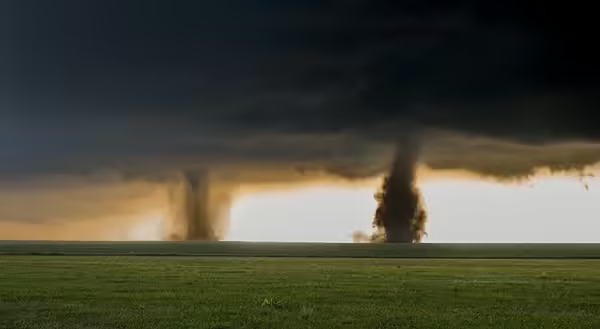
At the time I’m writing this, Twisters, the sequel to the cow-flying film Twister released in 1996, just hit the movie theatres. Luckily, I didn’t make a spectacle of myself during the original, shouting out about all the scientific inaccuracies. While I have not yet seen the new movie, I do want to talk about the weather of twisters, as in multiple funnels.
Multiple vortex tornadoes
When there are very large tornadoes, in some cases a half to even a mile wide, these are not typically just one funnel, but multiple funnels. These multiple funnels, the fancy term is suction vortices, rotate around a central point. Picture a rotating area of air, and within that, there are much faster rotating columns of air that follow the larger rotation. You aren’t able to see the individual vortices because of all the dirt and debris that has been picked up.
These multiple vortex tornadoes are usually associated with supercell thunderstorms. These nasty storms are already slowly rotating – yes, the ENTIRE storm is rotating! Within the storm, rotation can become more concentrated, leading to rotation reaching the ground.
The complete mechanism for how this happens is still not completely understood, but research is getting much closer to knowing.
The damage path caused by these multiple vortex tornadoes helps explain something that, in the past, was unexplainable. As one of these tornadoes travels through a neighborhood, there have been many instances where some houses are destroyed while others are left with only minor to moderate damage. If a house is directly hit by one of these vortices, where the winds may be much greater than 150 miles per hour, the house may not stand. If a house happens to fall in between vortices, where the winds may only be 70-90 miles per hour, there may only be roof and siding damage.
Satellite tornadoes
Another type of multiple tornado occurrence is called satellite tornadoes. These are smaller tornadoes that are separate from a larger tornado but are part of the general area of rotation. They do move around the larger tornado, but most of the time, they are visible as a distinct tornado.
There can also be two close but separate areas of rotation in a storm that can create what’s called “twin” or “sister” tornadoes, like the photo paired with this article. While they don’t occur often, there are several videos of these events that can be seen online. There was an occurrence of twin tornadoes about a half mile apart from each other in my home area about 30 years ago.
So, while you’re munching your popcorn at the movie theatre, just enjoy the special effects and try not to get upset about scientific inaccuracies. I will do the same!
About the Blog
The All About Weather blog by Duane Friend explores the environment, climate, and weather topics for Illinois. Get in-depth information about things your weather app doesn't cover, from summer droughts to shifting weather patterns. Never miss a new post!